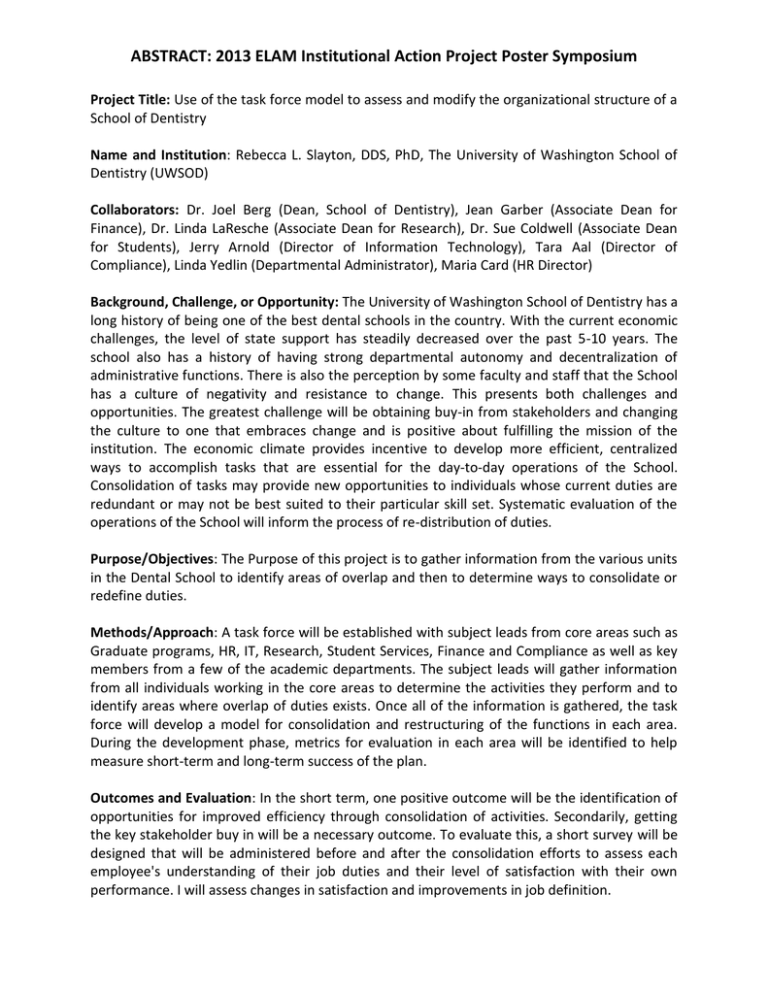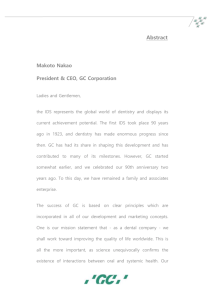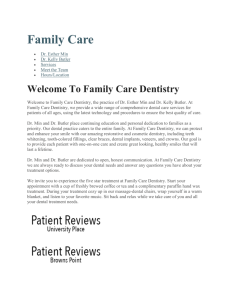ABSTRACT: 2013 ELAM Institutional Action Project Poster Symposium
advertisement

ABSTRACT: 2013 ELAM Institutional Action Project Poster Symposium Project Title: Use of the task force model to assess and modify the organizational structure of a School of Dentistry Name and Institution: Rebecca L. Slayton, DDS, PhD, The University of Washington School of Dentistry (UWSOD) Collaborators: Dr. Joel Berg (Dean, School of Dentistry), Jean Garber (Associate Dean for Finance), Dr. Linda LaResche (Associate Dean for Research), Dr. Sue Coldwell (Associate Dean for Students), Jerry Arnold (Director of Information Technology), Tara Aal (Director of Compliance), Linda Yedlin (Departmental Administrator), Maria Card (HR Director) Background, Challenge, or Opportunity: The University of Washington School of Dentistry has a long history of being one of the best dental schools in the country. With the current economic challenges, the level of state support has steadily decreased over the past 5-10 years. The school also has a history of having strong departmental autonomy and decentralization of administrative functions. There is also the perception by some faculty and staff that the School has a culture of negativity and resistance to change. This presents both challenges and opportunities. The greatest challenge will be obtaining buy-in from stakeholders and changing the culture to one that embraces change and is positive about fulfilling the mission of the institution. The economic climate provides incentive to develop more efficient, centralized ways to accomplish tasks that are essential for the day-to-day operations of the School. Consolidation of tasks may provide new opportunities to individuals whose current duties are redundant or may not be best suited to their particular skill set. Systematic evaluation of the operations of the School will inform the process of re-distribution of duties. Purpose/Objectives: The Purpose of this project is to gather information from the various units in the Dental School to identify areas of overlap and then to determine ways to consolidate or redefine duties. Methods/Approach: A task force will be established with subject leads from core areas such as Graduate programs, HR, IT, Research, Student Services, Finance and Compliance as well as key members from a few of the academic departments. The subject leads will gather information from all individuals working in the core areas to determine the activities they perform and to identify areas where overlap of duties exists. Once all of the information is gathered, the task force will develop a model for consolidation and restructuring of the functions in each area. During the development phase, metrics for evaluation in each area will be identified to help measure short-term and long-term success of the plan. Outcomes and Evaluation: In the short term, one positive outcome will be the identification of opportunities for improved efficiency through consolidation of activities. Secondarily, getting the key stakeholder buy in will be a necessary outcome. To evaluate this, a short survey will be designed that will be administered before and after the consolidation efforts to assess each employee's understanding of their job duties and their level of satisfaction with their own performance. I will assess changes in satisfaction and improvements in job definition. Use of the task force model to assess and modify the organizational structure of a School of Dentistry R.L. Slayton, DDS, PhD, J. Berg, DDS, MS, J. Wataha, DMD, PhD, L. LaResche, ScD, J. Garber, T. Douglas, L. Yedlin, S. Coldwell, PhD, J. Arnold, T. Aal, M. Card The University of Washington School of Dentistry Background Challenge/Opportunity The University of Washington School of Dentistry has a long history of excellence in dental education and research. With the current economic challenges, the level of state support has steadily decreased over the past 5-10 years. The school also has a history of having strong departmental autonomy and decentralization of administrative functions. In addition, there is the perception by some faculty and staff that the School has a culture of negativity and resistance to change. This presents both challenges and opportunities. The greatest challenge will be obtaining buy-in from stakeholders and changing the culture to one that embraces change and is positive about fulfilling the mission of the institution. The economic climate provides incentive to develop more efficient, centralized ways to accomplish tasks that are essential for the day-to-day operations of the School. Consolidation of tasks may provide new opportunities to individuals whose current duties are redundant or may not be best suited to their particular skill set. Systematic evaluation of the operations of the School will inform the process of re-distribution of duties and improvement of processes. Outcomes and Evaluation Purpose/Objectives by J. Wataha In the short term, one positive outcome will be the identification of opportunities for improved efficiency through consolidation of activities. Secondarily, getting key stakeholder buy in will be a necessary outcome. To evaluate this, a short survey will be designed that will be administered before and after the consolidation efforts to assess each employee's understanding of their job duties and their level of satisfaction with their own performance. Changes in satisfaction and improvements in job definition will be assessed. The Purpose of this project is to define the current state of the organizational structure of the Dental School, identify areas of inefficiency or overlap and create an ideal state that maximizes both quality and efficiency. Methods/Approach A task force was established with subject leads from core areas such as Graduate programs, HR, IT, Research, Student Services, Finance and Compliance as well as key members from academic departments. The subject leads will gather information from all individuals working in the core areas to determine the activities they perform and to identify what duties are being performed and how often. Once all of the information is gathered, the task force will meet with key stake-holders from each unit to clarify findings, address questions and concerns and foster buy-in. Strategies for improvement will be developed including creating a model for consolidation and restructuring of the functions in each area. During the development phase, metrics for evaluation in each area will be identified to help measure short-term and long-term success of the plan. Discussion Organizational Structure Task Force D M A I C Define Measure Analyze Improve Control Define the current state Determine current activities Develop focused problem statement Creative possible solutions for root causes Develop and document standard practices Gather data Refine the problem statement Explore potential causes Select solutions to reach ideal state Train teams Understand the voice of the customer (VOC) Plan & execute data collection plan Use tools to determine cause & effect relationships Develop improvement plan Monitor performance Pilot plans Summarize and communicate findings Implement plans Recommend future plans Identify the key measures you will be monitoring Determine root causes of problem [Modified from S. Moffat-Bruce] Measure results Evaluate benefits This project is in the early stages of implementation. It is part of a larger school wide project intended to restructure all activities within the dental school including the curriculum, the clinical enterprise and the organizational structure. It has the potential to have a dramatic impact on the Dental School and to improve the quality of patient care, dental student education and graduate student education while maintaining fiscal responsibility. Summary/Conclusion The response of faculty and staff to date has been cautiously optimistic. It is anticipated that the entire process will take a year or more to complete. Continued training and re-assessment of goals will be critical. Presented at the 2013 ELAM Leaders Forum



